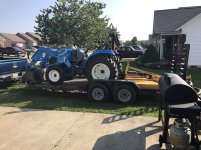I think that is just a matter of overall numbers. There are more privately owned 1/2T than 3/4T and 1T, so naturally more are involved in accidents; although I'm with Diamondpilot on the point, I've personally not seen any higher instance of wrecked 1/2 tons as anything else on the road.
You're correct, there are classifications for a reason. But a blanket statement that a 1/2 ton is not near the truck a 3/4 ton is, is not entirely accurate. For a given model year, yes, the 3/4 ton is a stronger truck than a 1/2 ton. A 3/4 truck from 1970 isn't near the truck todays 1/2 tons are. A 1/2 ton truck of today is more equal to a 3/4 ton of the year 2000. What the 1 tons are hauling these days required a semi-truck not too many years ago.
Not in every respect... Still missing safety features like Full floater rear axles
Even our 1967 F-250 2 wheel drive had a full floater. unless something has changed 1/2 tons still don't...
from Fourwheeler magazine
A full-floating axle can be found on the rear of some 4x4s, but it is generally reserved for vehicles that are designed for severe duty,
or are intended to carry heavy loads.
This type of axle uses an axleshaft on each side that is simply splined at both ends or splined on the inner end and has a drive flange on the outer end. The shaft mates to the differential in the same way as a semi-floater. However, the outer end of the shaft differs. Here, the splined end of the shaft slides into a locking hub or an internal splined steel drive plate that bolts to a hub cap, similar to what is found on a front axle. In some cases, the drive flange may be part of the shaft itself. In either case, the axleshaft is allowed to float in the system.
For a full-floater system, the axleshaft only serves to transmit the rotational torque from the differential out to the wheel.
It does not carry the weight of the vehicle like a semi-floater does. On a full floater, a spindle is attached to the outer end of the axlehousing. The hub's cap is attached to this spindle and rides on tapered roller bearings. It is this assembly that carries the vehicle weight.
As such, a full-floating axle system is considerably stronger than an equivalently sized semi-floating system.
For those of you who carry heavy loads, this means your axle load capacity is greatly increased with a full-floater. Load ratings for similar vehicles with the two different axles are usually significantly different.
should an axle shaft break on a semi floater there is nothing to retain the wheel/ tire, a broken axle shaft on a full floater will lose drive power but the wheel /tire will be retained.
Or has the 1/2 ton truly been upgraded in this area?



